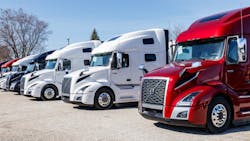When was the last time you really looked at the percentage of time you are using each of your assets across your entire network? While some fleet managers may be disciplined in this process, for many others, it may have been quite a while ago. Between operational changes necessitated by COVID-19 and now scrambling to find parts, analyzing asset utilization may have slipped down on the priority list.
Given all the changes in product distribution that may have impacted retailers and other shippers, now might be a good time to take a closer look at your asset utilization percentages. However, it is not enough to have simply an overall asset utilization percentage. You need to quantify it for each individual asset.
While we all would love to see 100% utilization, we know that is unrealistic. Assets need to be down at times for maintenance and drivers’ hours of service rules can also impact utilization. Still, the goal is having each asset utilized to its full potential. In other words, you want assets on the road delivering products, not sitting idle on your lots.
Asset utilization is a fairly simply calculation. You take the total number of hours an asset is actually being utilized and compare that to the total number of hours it is available for service. Once you have the data for each asset, you can analyze the data by location and then across your entire network.
When you have completed the utilization analysis, you can start making decision about whether to change routing, delivery schedules, etc. to balance your asset utilization more evenly across your network. You can even consider moving assets from a location where they are being underutilized to a location where assets can be put in service to their fullest, or where you have had to turn down business because you could not meet demand.
With the delays in getting new vehicles, making sure you are balancing your asset utilization becomes even more important as you may have to hang on to vehicles longer than you originally planned.
Gino Fontana, CTP, is COO and EVP at Transervice Logistics Inc. Prior to this recent promotion, he was VP of operations at Berkeley Division and Puerto Rico. His operational expertise emphasizes cost savings, process efficiency and improvement, superior quality, and people management skills. He has more than 35 years of experience in the transportation and logistics industry with both operational and sales experience.
About the Author
Gino Fontana
Chief operating officer and executive vice president at Transervice Logistics Inc.
Gino Fontana, CTP, is COO and EVP at Transervice Logistics Inc. His operational expertise emphasizes cost savings, process efficiency and improvement, superior quality, and people management skills. He has more than 35 years of experience in the transportation and logistics industry with both operational and sales experience.
